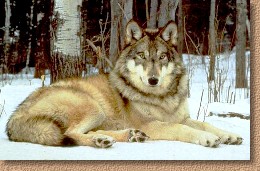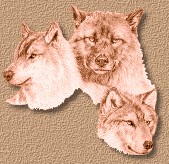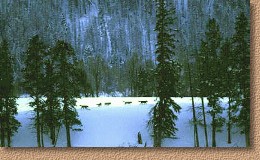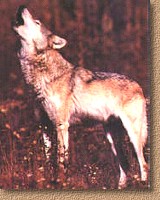|
The wolf is the largest of the canines, which include coyotes, jackals, dingos, and most domestic dogs. The gray wolf, Canis lupus, also called the timber wolf, is the largest of the wild species within the dog family. Originally, wolves were the most widely distributed mammal on land. But recently, they are either extinct, or threatened with extinction, throughout much of their natural territory.  Wolf and dog ancestors began to develop about sixty million years ago. By about twenty million years ago, canines and felines had branched into two separate families. Apparently a number of wolflike creatures diverged from a common ancestor about two to three million years ago. The first gray wolf probably appeared in Europe or Asia about a million years ago. Around 750,000 years ago, it migrated to North America. Wolf and dog ancestors began to develop about sixty million years ago. By about twenty million years ago, canines and felines had branched into two separate families. Apparently a number of wolflike creatures diverged from a common ancestor about two to three million years ago. The first gray wolf probably appeared in Europe or Asia about a million years ago. Around 750,000 years ago, it migrated to North America.The Dire Wolf, (Canis dirus), larger and heavier, co-existed in North America with the gray wolf for about 400,000 years. As prey became extinct around 16,000 years ago due to an ice age, the dire wolf gradually became extinct. Around 7,000 years ago the gray wolf became the prime canine predator in North America.  The gray wolf, Canis lupus, lives in the northern latitudes around the world. There are five subspecies of the gray wolf in North America. They are: The gray wolf, Canis lupus, lives in the northern latitudes around the world. There are five subspecies of the gray wolf in North America. They are:
In addition to gray wolves there are two other species of wolf in the world. The red wolf, Canis rufus, lives in the southeastern United States, and the Abyssinian wolf, Canis simensis, which some zoologists think is really a jackal, lives in Ethiopia.  Wolves usually live in packs made up of adult parents, their offspring of the last 2-3 years, and other unrelated wolves which sometimes join. Usually a pack has from six to eight wolves, but in Alaska and northwestern Canada some packs have over 30 members. A pack normally has only one litter of pups each spring, but in areas where there are lots of prey, more than one female will have babies in each pack. Wolves usually live in packs made up of adult parents, their offspring of the last 2-3 years, and other unrelated wolves which sometimes join. Usually a pack has from six to eight wolves, but in Alaska and northwestern Canada some packs have over 30 members. A pack normally has only one litter of pups each spring, but in areas where there are lots of prey, more than one female will have babies in each pack.Usually about six pups are born, but some may die if there is not a lot of food. Wolves form strong emotional attachments to other members of their pack. Pack territories cover from 50 to 350 square kilometres, but in Alaska and Canada, where there is more room, territory sizes can be up to 2500 square kilometres. Wolves in a pack may travel 15 to 45 km each day in search of food. Wolves usually prey on large mammals such as white-tailed deer, mule deer, moose, elk, caribou, bison, Dall sheep, musk oxen, and mountain goat. Beaver and rabbit are also on the menu, as are birds or small mammals. Mice are a particular favourite. Wolves need about a kilogram of food per day, but require more if they are to be healthy enough to reproduce successfully. Studies in Minnesota, where there are still a large number of wolves, have shown that the number of deer killed each year by wolves is about equal (or some years less than) the number killed by hunters or run over by vehicles. Wolves, unlike human hunters, will usually kill prey that is weak, sick, old, or young. This helps to keep the populations of deer, caribou and moose at a healthy level. The wolf has very strong jaws. The jaws of a wolf have a crushing pressure twice that of a large dog such as a German Shepherd. Wolves do not chew their food; they rip off chunks and swallow them whole. The remains of animals killed by wolves often later become meals for coyotes, foxes, birds, and other smaller creatures. In nature, nothing is wasted.  Wolves in the wild have an average life span of 6 to 8 years, but wolves have been known to live up to 13 years, and 16 years in captivity. The two main natural causes of wolf death are starvation, which usually kills pups, and death from other wolves in territory fights. Injuries caused by their prey also account for some deaths. (Moose, even sick ones, are dangerous!) Killing by humans, both legal and illegal, can also be high in some areas. Wolves love to play. In pups, play develops strength and hunting skills, and aids in establishing pack communication. But adult wolves will play as well; adult wolves stage mock fights, play chase, and leap on each other. The ambushing of unwary pack members is a favorite game. The body language of a wolf is similar to that of a dog:
Wolf numbers are declining across North America as people move into their territories. However, wilderness areas, particularly in Canada and Alaska, still support large wolf populations. In many areas, the wolf is a protected species, but limited hunting is allowed in some places. |